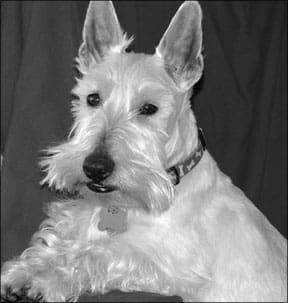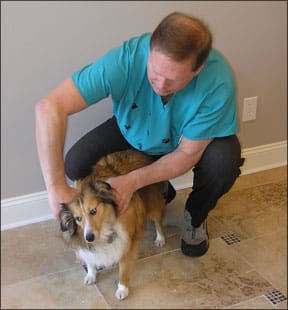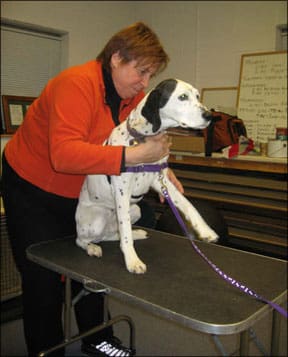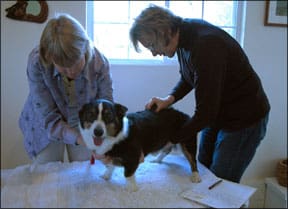Everyone knows that chiropractors are bone and joint doctors. They help alleviate back pain and other aches by making adjustments that improve skeletal alignment and musculoskeletal function. In recent years, chiropractic adjustments have become popular for dogs, especially those recovering from accidents or injuries.
But did you know that chiropractic care can improve a dog’s digestion; speed healing after illness or surgery; treat behavior or mood changes; help alleviate ear infections, urinary incontinence, and allergies; and even correct neurological imbalances?
Cheryl Morris, DC (Doctor of Chiro-practic), a chiropractor for humans in Congers, New York, knew something was wrong with Stanley Queue, her five-year-old Scottie. He vomited spontaneously three or four times a day several times a week, and when she palpated his abdomen, his diaphragm felt tight.
Stanley’s digestive problems were her main concern, but he also limped because of hind leg weakness. Five months ago, she took him to chiropractic veterinarian Sue Ann Lesser, DVM. Dr. Lesser conducts monthly animal chiropractic clinics in New York, New Jersey, Pennsylvania, Connecticut, and Maryland.
“After that first adjustment,” says Dr. Morris, “Stanley’s tail was up for the first time in months, he walked normally, and he went for an entire week without throwing up. Even after his vomiting returned, it happened less often and was less intense.”
Dr. Lesser suggested a change of diet, so Dr. Morris switched dog food brands and protein sources. “That made a big difference,” she says. “At his second appointment, his thoracic lumbar junction needed adjustment, and after that he kept improving. So far Stanley has had five adjustments, and he keeps getting better.”

288
In another chiropractic success story, Cassie, a spayed female Shepherd mix, suffered from urinary incontinence until chiropractic veterinarian Cindy Maro, DVM, adjusted her fifth lumbar vertebrae, sacral apex, and the base of her sacral bone. As soon as she did so, Cassie’s urinary leakage and long-term bowel and anal gland problems disappeared. (We discussed this case in more detail in “Not Just for Sore Backs,” Whole Dog Journal October 2003.)
Some breeders coping with reproductive problems consider chiropractic a fertility treatment because so many of their dogs conceived after being adjusted.
Even hot spots and lick granulomas may respond to chiropractic adjustments. Last summer my Labrador Retriever, Chloe, developed a lick granuloma on her right front paw. At her monthly appointment, Dr. Lesser said, “I’m not surprised. Her toes were jammed.” After a quick toe-freeing adjustment, Chloe forgot about chewing her foot.
Chloe’s problem had a mechanical cause, but dozens of conditions that have no obvious connection to the skeleton and its alignment respond to chiropractic treatment. As the American Veterinary Chiropractic Association (AVCA) website explains, all of the body’s organs are connected to nerves that run between vertebrae, and adjustments in these areas can change or influence nervous system input and blood flow as well as hormones and neurotransmitter levels directly affecting organs, glands, skin, and joints.
“Every dog is an individual,” Dr. Lesser says, “and responses vary, but I truly can’t think of a medical condition that won’t be helped in some way by chiropractic adjustments. I’m never surprised when dogs respond to chiropractic treatment, even for conditions like infections, skin and coat problems, digestive disorders, behavioral problems, and recovery from the use of anesthesia. This doesn’t mean that chiropractic care is a stand-alone treatment that replaces conventional veterinary care. Chiropractic is a complementary or support therapy. A thorough veterinary exam should always precede any chiropractic evaluation.”
To help determine whether your dog will benefit from chiropractic treatment, see “Biomechanical Evaluation” by Randy Kidd, DVM, PhD (August 2002 Whole Dog Journal). Dr. Kidd’s descriptions and checklists will help you see your dog from a new perspective, keep accurate health records, and make more informed decisions about your dog’s care.
America’s veterinary chiropractors
The formal training of veterinary chiropractors in the U.S. began in 1989 with a 100-hour post-graduate course developed and taught by Sharon Willoughby, DVM, DC, in which veterinarians and chiropractors were trained side by side. In programs approved by the AVCA, that practice continues today. Veterinarians receive a foundation of chiropractic theory and technique, while chiropractors study common animal diseases, comparative anatomy, and animal-handling techniques. Adjustments are taught with both dogs and horses.
Licensing regulations vary by state. In New York, where Dr. Morris adjusts human patients, chiropractic treatment can be given to dogs and other animals only by licensed veterinarians. Even if she studied veterinary chiropractic, Dr. Morris could not legally treat animal patients in New York State. Across the border in New Jersey, Dr. Morris could practice on animals with a veterinarian’s referral. Currently no states allow chiropractors to work on animals without a veterinarian’s referral or, as in California, a vet’s supervision.

288
Are the approaches of veterinarians who learn chiropractic techniques and chiropractors who learn about veterinary medicine different? Because of their training, chiropractors are likely to have a better understanding of the actual adjustment technique, while veterinarians are more familiar with animal anatomy, handling methods, and specific illnesses.
But it’s more likely that personality traits, interests, experience, and other factors will determine which veterinary chiropractor will best help your dog. The same is true when choosing a chiropractor or healthcare practitioner for yourself.
The AVCA defines a chiropractic adjustment as “a short-lever, high-velocity controlled thrust by hand or instrument that is directed at specific articulations to correct vertebral subluxations.”
“Subluxation” describes the misalignment of vertebrae resulting in a disturbance of normal function. Subluxations may cause animals and people to compensate for resulting pain with changes in posture or movement, such as shifting weight or avoiding certain motions. Secondary subluxations can occur in other parts of the spine as a result, creating complications.
When a vertebral subluxation is diagnosed, the chiropractor re-establishes normal motion with an adjustment. When properly performed, this thrust mobilizes or frees the vertebrae and restores normal function in that spinal segment. As a result, spinal adjustments may reverse a variety of nerve, muscle, and motion problems.
Subluxations can cause abnormal or uneasy posture while standing or sitting, a refusal or unwillingness to go over jumps, the development of unusual behavior patterns such as biting or growling, unusual sensitivity to touch, a lack of coordination or gait abnormality, stiffness on rising, stiffness in lateral movements of the back or neck, muscle atrophy, lameness in hindquarters, abnormal biting or chewing of the coat or tail, increased sensitivity to heat or cold, and limited range of motion.
“The problems that subluxations cause might be visible and obvious, or they may still be developing,” says animal chiropractor Marc L. Sommer, DC, of Pompton Lakes, New Jersey. “We think of the subluxation as the problem, its adjustment as the cure, and the improvement of symptoms as a desired side-effect. Most animals show significant improvement after one to four adjustments.”
In chiropractic examinations, major muscle groups are checked for atrophy, hypertrophy, tone, symmetry, heat, tenderness, and pain. In addition, the spine is palpated and examined for abnormal protuberances, restricted motion, and other unusual features.
Some veterinary chiropractors use only their hands while others employ a small spring-loaded impacting device called an activator to provide mechanical-force, manually assisted adjustments. Both methods have their proponents, and individual preferences vary. (All of the practitioners mentioned here use their bare hands.)
Large and unwieldy devices like mallets or hammers are not needed to adjust even the largest animals, says Dr. Sommer, and they can create more acute and serious conditions. Other procedures that he warns against include the use of excessive force and jerking on the legs or tail. “These practices do not constitute a chiropractic adjustment, and they may exacerbate an already existing injury,” he says. “Remember that skill, not extreme force, is the key to successful adjustments.”
Typical patients
Trauma injuries remain the number one reason for bringing a dog to a veterinary chiropractor.
“When a dog is hurt, it’s important to deal with fractures and internal injuries first,” says Dr. Lesser, “but after that, chiropractic care speeds recovery from any injury, including being hit by a large object like a car, bus, train, or another dog of equal or greater size. Dogs often injure themselves by body slamming, playing bump-and-run, and other canine games. Or they hit a large immoveable object such as a wall while playing ‘magic carpet ride,’ or they fall off the porch, deck, bed, or dog walk, or down a flight of stairs.”

288
Among medical maladies, she says, chiropractic adjustments speed recovery from surgery and the use of general anesthesia as well as chronic ear infections, especially those that occur in only one ear, and a host of structural problems.
For example, dogs with hip dysplasia often feel better when adjusted. “While chiropractic cannot cure the bilaterally dysplastic dog, they are more comfortable when the rest of the body moves properly,” says Dr. Lesser. “Dogs with unilateral hip dysplasia in the absence of trauma have sacral-pelvic misalignments that biomechanically stretch the ligaments and joint capsule of the hip. Straightening the dog’s hind end and specifically conditioning the dog will often eliminate unilateral hip dysplasia.”
Chiropractic adjustments can be used to treat persistent lameness, including lameness that does not respond to anti-inflammatory therapy and chronic lameness that is secondary to long-term orthopedic treatment like cruciate ligament surgery. “It might not be the surgically treated elbow or knee that is bugging the dog,” Dr. Lesser explains. “The problem may be the compensations that his body has made since the knee or elbow was injured.”
Disc disease at any spinal level or severity, she cautions, should be treated only in conjunction with conventional or holistic veterinary care. Acupuncture combined with chiropractic care may improve the outcome.
Dogs with arthritis usually respond well to chiropractic adjustments in conjunction with acupuncture and medical therapy, including the use of nutritional supplements such as Glycoflex or Cosequin, says Dr. Lesser. “These treatments can provide the arthritic dog with a better quality of life. Interestingly, dogs with significant arthritic changes seen in their x-rays usually have good mobility in their joints, while older dogs with ‘clean’ x-rays usually have a reduced range of motion.”
Another of Dr. Lesser’s risk categories is what she calls “occupational hazards.”
“Here we have dogs who were playing or working and then became acutely lame. Their lameness usually improves with minimal conventional treatment, but after that the dog is never ‘quite right.’ The category includes all competition dogs at all levels. Any decrease in performance is a symptom, such as a competition dog who isn’t placing or scoring as high as previously, won’t hold a sit/stay, won’t ‘stack’ (hold a pose in the conformation show ring) without shifting, is suddenly slow to retrieve, or simply doesn’t work as well or as enthusiastically as previously.”
Dr. Lesser lists poor leash manners as the number-one cause of cervical (neck) problems, followed by inappropriate leash corrections as the number-two cause. “And then there are all the problems that come with always heeling on only one side in both breed and obedience,” she adds. “Any unilateral activity creates muscle imbalances that can profoundly affect the dog’s gait. For every five minutes that a dog heels on the left, he should heel on the right. Dogs do not have difficulty switching sides; people do. In addition, dogs who routinely turn in one direction while racing out the kitchen door to chase squirrels will exhibit much the same subluxation patterns as dogs who heel only on the left side.”
Dr. Lesser’s final risk category is something she calls “dogs are dogs.” Here she includes any American-bred German Shepherd Dog more than four years of age; dogs who vigorously play ball, Frisbee, and fetch games; dogs who chase squirrels, cats, and other creatures; dogs whose notion of fun is a flying leap into space; dogs who play actively in deep snow, especially those who bound, porpoise, plow, or tunnel; and any dog who has way too much fun.
“While subtle at first,” she says, “over time minor injuries associated with these activities accumulate and your exuberant playmate becomes an ‘old arthritic dog’ well before his time. Then he won’t jump onto the couch or bed, won’t go up or down stairs, won’t jump in or out of the car, and is slow to stand up or lie down.”

288
To this list of conditions and symptoms that respond to chiropractic adjustments, the AVCA adds old age, any chronic health problems that do not resolve as expected, and seizures or neurological problems.
Chiropractic assessment
What do veterinary chiropractors look for when they first see a patient? Dr. Lesser observes the dog’s posture, as well as his level of alertness when he initially enters the treatment area. Then she has the patient walk with his handler away from and toward her while she checks his tail position, gait, and overall appearance.
“The dog may show a personality change by seeming not as active or happy as usual,” she explains. “He may start snapping or look like he has a headache or an anxious facial expression. The tail might not wag symmetrically, or it may be clamped or held straight out from the body. I look for a rolling motion through the back, which might not be there or it may stop at one point. When I touch the dog, there might be a lumpy or bumpy feeling through the spine, especially near the back of the rib cage. In severe cases, the back may look like a tent. I notice whether the dog’s head is tilted or the dog has trouble turning his head in one direction, including up or down.
“The dog might scuff one foot while gaiting, the hind legs may look stilted, or there can be a lack of symmetry from limb to limb. Most commonly there is a catch or rattle through the shoulder or hock, or differences in muscling. The skin on one area of the back may move or wiggle when touched. One side of the dog’s croup may be higher than the other.”
In contrast, Dr. Lesser explains, “Correctly aligned dogs have a certain presence and glow about them, and they’re so balanced that your eye isn’t drawn to any particular part of the body. If your eye is drawn to the back, pelvis, head, or other part, it’s because something there isn’t moving correctly. Any dog whose appearance invites meticulous analysis of gait should be chiropractically examined.”
Most dogs accept their chiropractic examination and treatment without significant discomfort, and practitioners are trained to use gentle techniques to reduce pain before delivering adjustments. Patients typically show immediate improvement, though adjustments are often followed by 24 to 48 hours of fatigue, and some dogs require several sessions to resolve acute pain and re-establish and maintain normal function of the joints and nervous system.
For your dog’s best treatment response, the AVCA recommends sharing information about her medical history and treatment from all healthcare providers, including diet, supplements, and medications. In addition, be sure you understand the animal chiropractor’s recommendations regarding post-adjustment exercise and home therapy.
Trends in canine chiropractic
One of the biggest trends in today’s chiropractic care for animals is the scheduling of monthly appointments for routine maintenance, especially for competition dogs.
“Among performance people,” says Dr. Lesser, “it’s becoming routine to get their dogs adjusted. They have observed that their dogs perform better, stay sounder, have fewer injuries, and in general are ‘healthier’ as a result. My clients have repeatedly commented that their dogs are living longer and with better quality of life in their golden years. Whether that’s due strictly to chiropractic or a combination of chiropractic and better awareness of nutrition, conditioning, and training, I can’t say for sure, but I always feel that I’m part of the team that helps Rover feel better and do better.”
Dr. Lesser, who has taken so many workshops that she calls herself a chiropractic education junkie, recently completed a Master’s Degree in Advanced Neurology of Veterinary Spinal Manipulative Therapy (VSMT), a post-graduate program offered by the Healing Oasis Wellness Center in Sturtevant, Wisconsin.
“My first research paper for this course,” she says, “evaluated whether dogs improve their appearance after an adjustment. According to my panel of experts (two conformation judges and an expert on canine structure) and my professional colleagues in the advanced class, an adjustment does definitely improve the posture and therefore the appearance of dogs.
“My second paper is titled ‘Why Dogs Should Dance: The Neurobiology of Music and Canine Freestyle.’ I have observed through the years that the highest-level freestyle dogs are the most superb athletes in my five-state practice. So I asked the question, ‘Why is that?’ One hundred seventy pages later, I think I found the answer. In a very small way, it’s the canine version of This Is Your Brain on Music, by Daniel J. Levitin, or Musicophilia, by Oliver Sacks.” (For ordering information, see “Resources Mentioned in This Article,” below.)
What is her most interesting or exciting discovery about canine chiropractic? “This question makes me laugh,” she says, “because fellow VSMT practitioners and I are always exclaiming, ‘Hey, this stuff really works!’ Seventeen years ago I took the training to become certified in veterinary chiropractic and was amazed that by mobilizing the joints to move as they should, many positive things happened to the dog’s body.
“Now I’m amazed even more by the changes that result from receptor-based therapy, which is the manipulation of the nervous system through chiropractic adjustments and specific challenges to the senses, such as vision, hearing, smell, proprioceptors, etc. Yes, this neuro stuff really works. The wonderful thing about doing the new receptor-based therapy work, which I consider the cutting edge of canine chiropractic, is that the owners are intimately involved with the therapy homework. If they follow through with the prescribed exercises, incredibly positive changes can and do occur.”
Will your dog benefit from chiropractic? The growing number of qualified practitioners, satisfied clients, and well-adjusted dogs suggest that this hands-on approach to health and healing may improve almost any dog’s quality of life.
CJ Puotinen is author of The Encyclopedia of Natural Pet Care, Natural Remedies for Dogs and Cats, and other books (see “Resources,” page 24 for purchasing information). She lives in New York with her husband, a Labrador, and a tabby cat.






